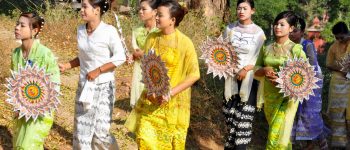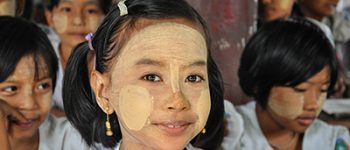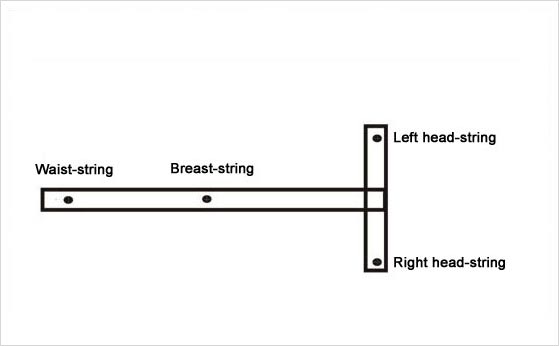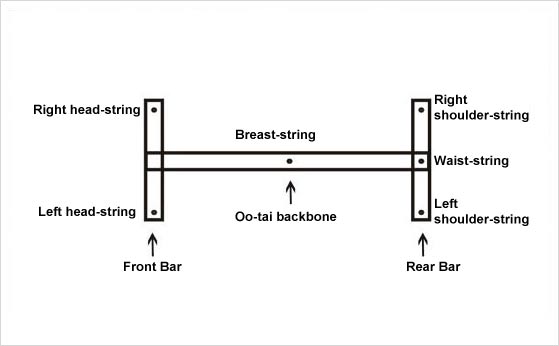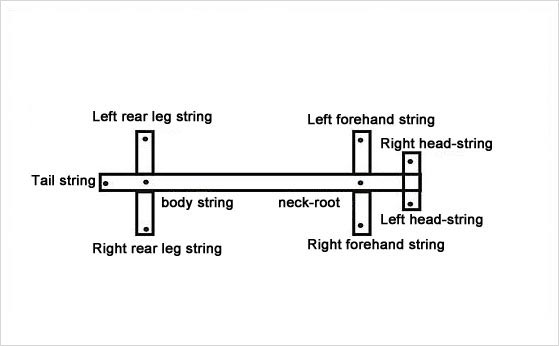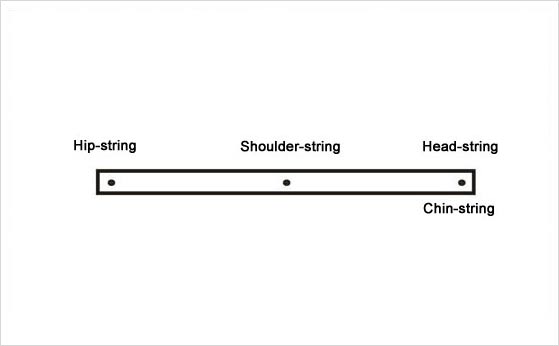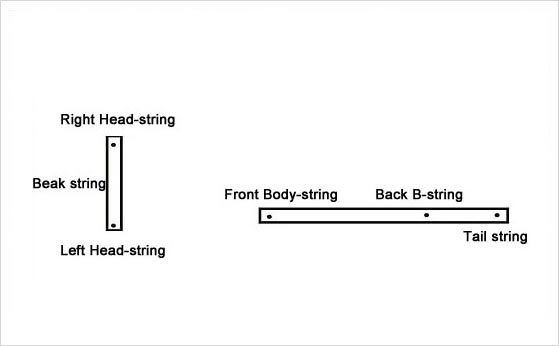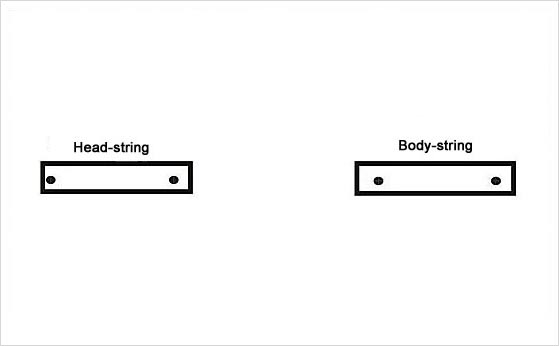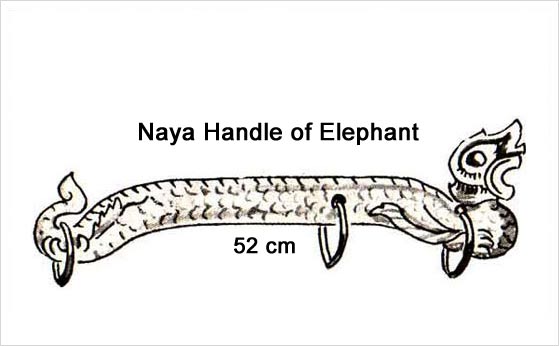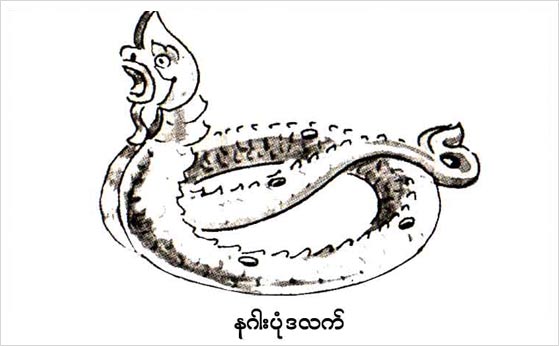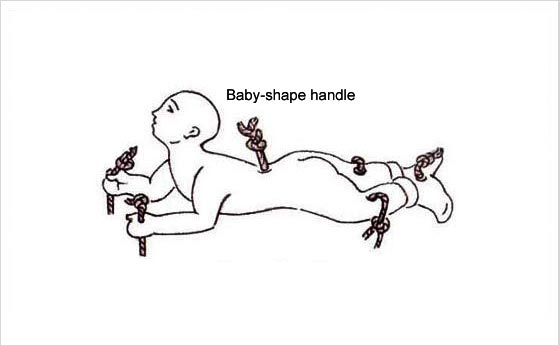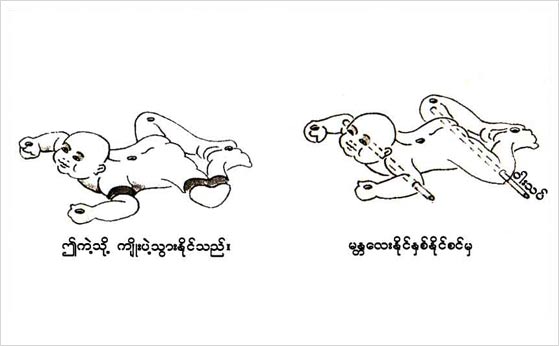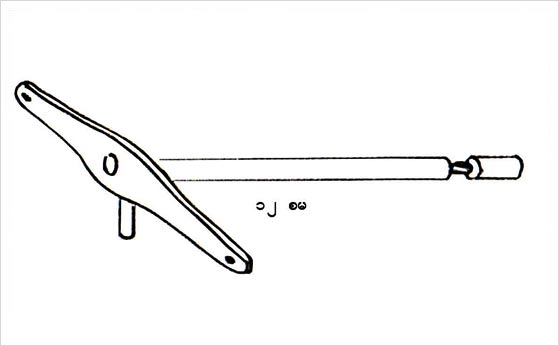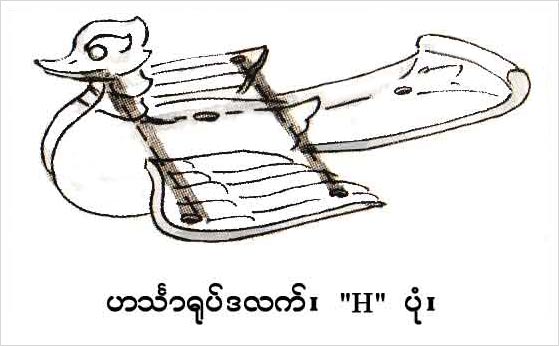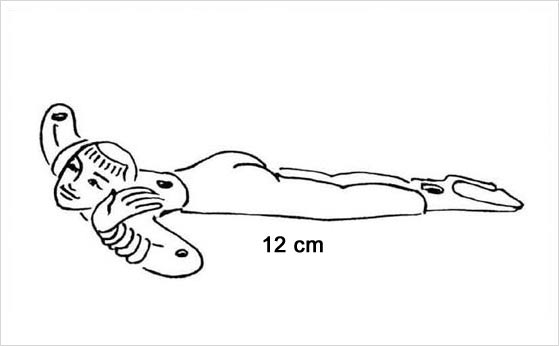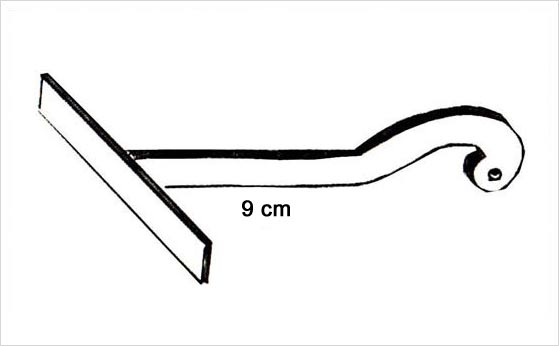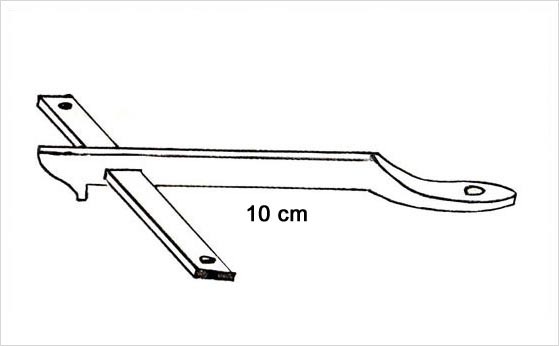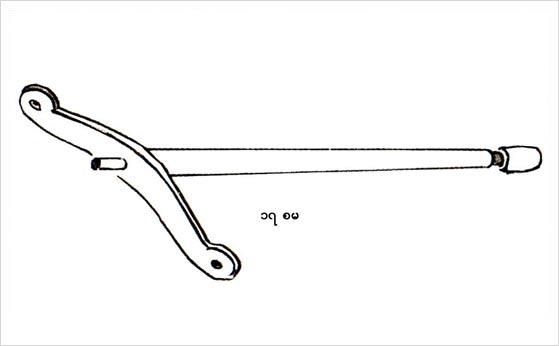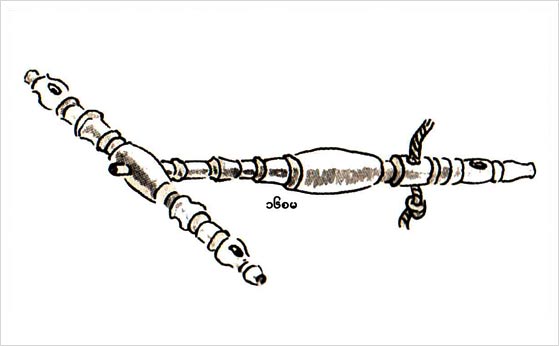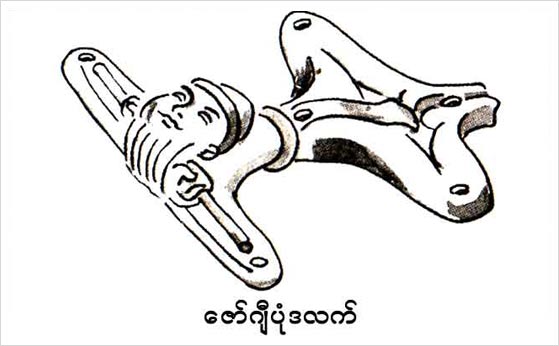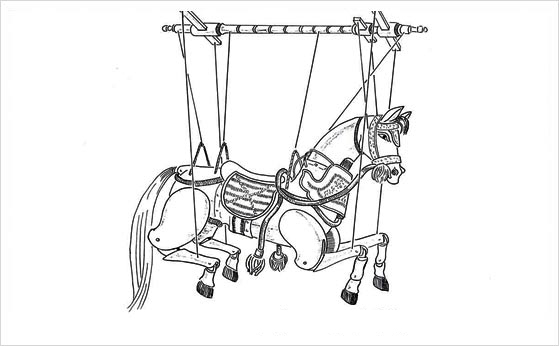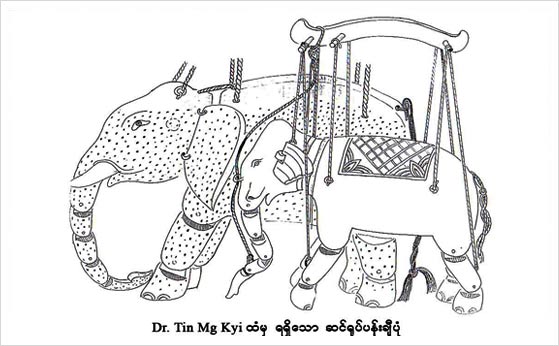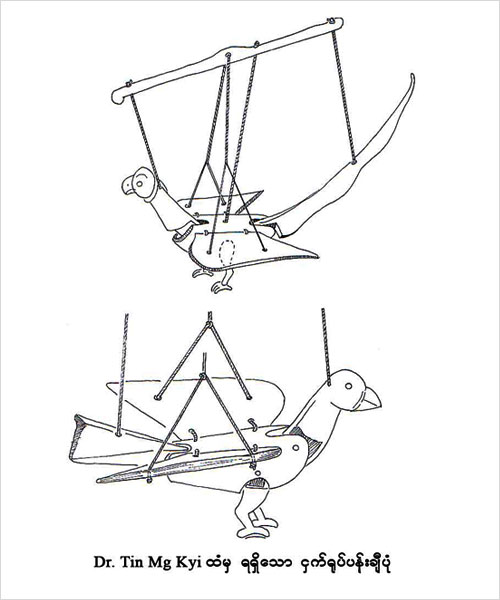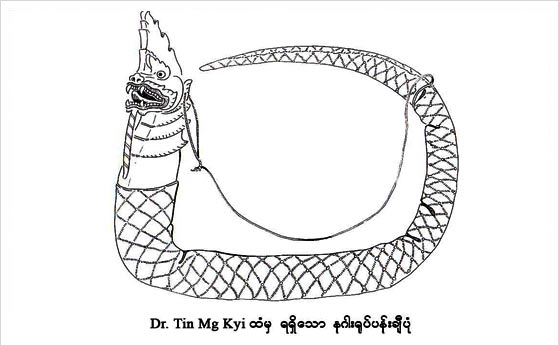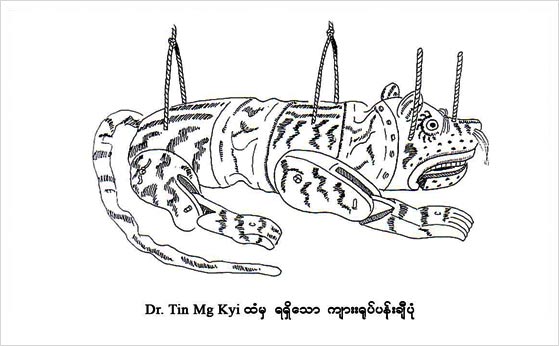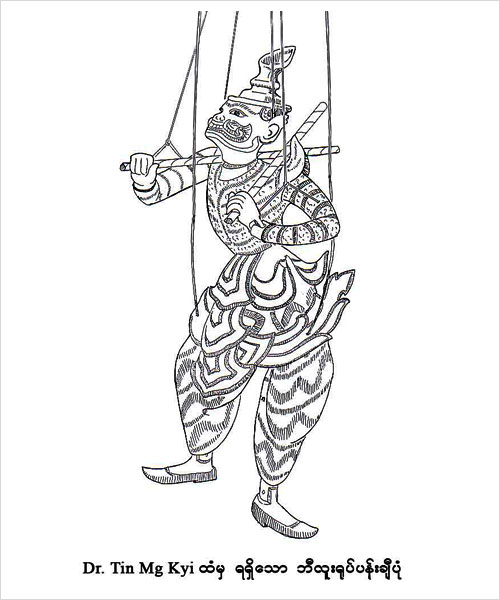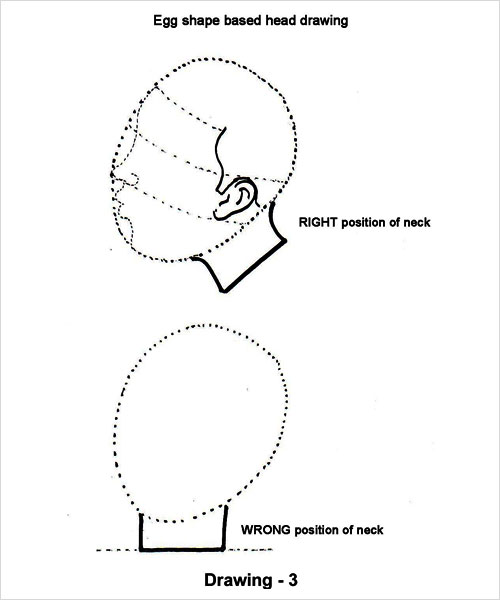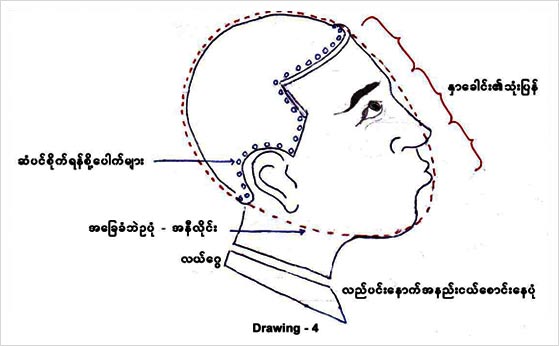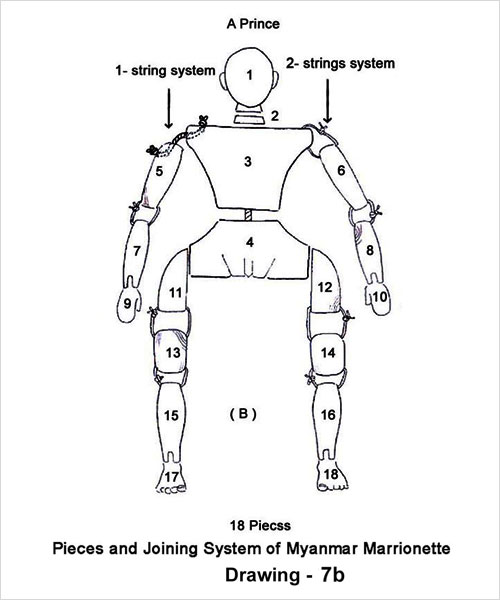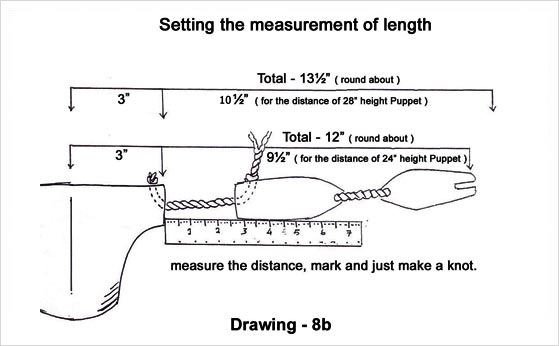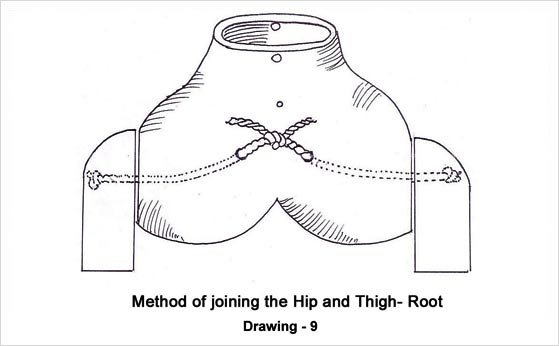Myanmar Puppets Figures
3.1 Abidhama Dolls
A. Mahabuta 4 matters
1. Earth (a) Minister (white face, hat and robe green)
2. Fire (b) Minister (red face, hat and robe green)
3. Water (c) Minister (white face, top-knot, turban and robe green)
4. Air (d) Minister (red Face, top-knot, turban and robe green)
B. 5 Pathada Materials
5. Eye-Pathada Material organ of seeing Senior Prince (Red Face)
6. Ear-Pathada Material organ of hearing maid
7. Nose-Pathada Material organ of smelling Galon
8. Zainwha Pathada Material organ of tasting Dragon
9. Kaya Pathada Material body organ Tiger
C. Yaugacara (7-)4 types
10. Yu-pa-yone object of vision Byanma
11. Thadda Yone object hearing King or Dinda
12. Ganda Yone object of smell Good God
13. Yatha Yone object of taste Joker-god
D. 2 Bawa Material
14. Eitthi Yoke feminine factor Princess
15. Pone Yoke muserline factor Prince
E. Hadaya 3- Materials
16. Hadaya Material heart element Sweet Song Clown
F. Ziwita Material 1
17. Ziwita Material healthy state Hermit
G. Ah-ha-ra Material 1
18. Ah-hara Doll nourishment Akward Song Clown
H. Pri-cae-da Material
19. Ah-ka-tha Doll element of space Senior Prince (White Face)
I. Wi-nyet Material 2
20. Kaya Winyet Doll physical expression Ogre
21. Wazi winyet Doll verbal expression Gon-ban
J. Wikara Material 3
22. Lahuta Doll physical flexibility Zaw
23. Muduta Doll physical versatility Elephant
24. Kamanyata Doll physical fitness Horse
K. Let-kha-na Material 4
25. Upadaya Doll physical development Boy
26. Thatati Doll physical endurance Old Man
27. Zarata Doll physical deterioration Old Woman
28. Anaita Doll physical change Monkey
Note: Pali words used by classifier were not translated nor explained. “Doll” was used by the writer for a character or image.
After recognizing 28 Abidama, there arose different (28) characters. In spite of differences basically one celestial being, one good sprit, one awkward spirit, Nat-ka-daw one, Hermit one, King one, Prince one, Princess one, White-faced Senior Prince, Red-faced Prince one, Two clowns, 4- Ministers, one Ponna, Old man one, Horse one, Monkey one, Ogre two, Galon (mythical bird) one, Dragon one, Black Elephant one, Tiger one, Zawgyi(Alchemist) one.
In the different (28) character the following special characters were included.
1. Byamar
2. Ritual or Maid
3. Sweet Song —-
4. Awkward Song
5. Rich man
6. Little offspring
7. Royal Prince
8. Queen
9. Page Boy
10. Witch
11. Ogre
12. Gonban
13. White Elephant
14. Elephanteer
15. Elephant-scare
16. Parrot
17. Big Bird (Wun Po)
18. Nga-pyu (villain)
Out of different 28- Characters system at least (2) or (6) special dolls of (18) could be included.
It seemed that marionette-artists and Marionette Troupe chose characters in accordance with their drama and plots. That was why different system arose.
3.2 Created characters in line with tradition and drama
Traditionally ancient Marionette Troupe differed in fixing number of dolls. The records showed that 28-characters systems (Abidhama Dolls) were not the same in doll-types and notes on them. For instance, in the regime of Alaungpaya (a) King Badon Theatrical Wun, U Thaw, had ordered to have 36-characters but no listed record was mentioned in his order.
Otherwise Sayagyi U Thein Naing in national-literature prized award, “Myanmar Marionette Theatre”, mentioned that limit of 36-dolls as follows:-
1. Hermit
2. Thagya
3. Good God
4. Mingyi
5. King
6. Prime Minister
7. Thet-taw-shay Wun
8. Wundauk
9. Wundauk Wun
10. Gate Wun
11. Myo Wun
12. Maha Wun
13. Elephant-scare
14. King in the palace
15. Royal House Prince (tragedy)
16. Prince
17. Princess
18. Page (right)
19. Page (left)
20. Ponna
21. Old Man
22. Old Woman
23. Maid (left)
24. Maid (right)
25. Horse
26. Elephant
27. Tiger
28. Monkey
29. Palace Ogre
30. Forest Ogre
31. Zawgyi
32. Galon
33. Dragon
34. Bad god
35. Parrot
36. Dog
In performing Sanda Kain-na-yee Drama Sanda-kain-na-yee puppet, in performing Pro-Buddha King Rabbit Drama Rabbit-puppet, in performing Thi-ha-ba-hu Lion-puppet, in performing King Hintha Drama Hintha-puppet, in performing King Pig Drama Pig-puppet and in performing One Act Play Chin-national puppet, and Kayin-national puppet and etc: were added respectively. So there have no fixed puppets should not be noted.
In analyzing the main puppets and added puppets should be noted as follows: –
Himalaya Scene
1. Horse
2. Elephant
3. Ogre
4. Monkey
5. Zawgyi
6. Bird
7. Tiger
These puppets were included in every Marionette Troupe. Some included white Elephant as well as Black Elephant.
Some, on the other hand, added horse-guard together with horse as an amusement.
As to ogres, forest-ogre, palace-figure, Konba and Konban, ogre and Konban, ogre and ogress were variably included.
As to Zawgyi, there were forest-Zaw and palace-Zaw. The intention was to differ rough dancing and polite dancing.
As to birds, Big Bird Wunpo, Parrot and Owl were separately included. Some included one type, some two types and some three types.
Horse, tiger, ogre, monkey and Zawgyi were seen in every Marionette Stage. Dragon, Galon (Mythical bird), Elephant and Bird were present in some Stages.
For dancing,
1. Prince
2. Princess (one or two)
3. 4-clowns (Page or Joker were alternative names.)
4. Nat-ka-taw or maid
5. Old man
6. Old woman
7. Sweet Song Doll (a king of Page)
8. Thu-nge-taw (Little child-other names: fore-runner, seat-planner)
Mostly, Nat-ka-taw puppet and maid-puppets were the same. 1stnight Nat-ka-taw, 2nd night Maid -.
Dramatic Puppets:-
1. Thagya
2. Nat (Good spirit, Martali and guardian-spirit of tree-)
3. Hermit (Tree-guard Bodaw or spirit)
4. King
5. Queen
6. 7/8/9 4 Wun (minister puppet) (Prime Minister, Shwe-taik Wun, Wundauk and Gote Wun or Myodaw Wun)
10. Senior Prince (Villain, Red Face)
11. Senior Prince (Polite Prince, White Face)
12. Bramar
13. Soldier
If those puppets were counted it exceeded (36) number. Actually, those puppets were used in performing Jatakas. Anyhow, when only the unavoidable puppets were used without reducing the number of puppets was less than (28). Dramatic puppets, created puppets and supplementary puppets were found as below:-
(A) Dramatic puppets:-
– Witch (Gon-puppet)
– Child-puppet (royal son, royal daughter)
– Rich man
– Senior Monk
– Pho Thu Daw
– Woman-villain, lion, rabbit and pig….
(B) Created supplementary puppets
– Horse-guard
– Elephant guard
– Hunter
– Glass-ball Player
– Pho Thu Daw
(C) Supplemented puppets with mask:-
Marionette-artists sometimes used head ware of King Elephant, King Peacock, King Dragon, King Pig, King Pigeon. For instance head ware of King Elephant had movable or immovable trunk.
It was probable that Himalaya Scene, Dancing Scene and Jataka Performance had vital dolls on which other necessary dolls were added. Thus those puppets appeared as creation according to nature.
3.3 Handles (Controls) of Myanmar Marionettes
These were described by U Hla Tha Main in his “Myanmar Marionette Theatre” and research scholar Dr. Tin Maung Kyi in his book, “Dr. Tin Maung Kyi and his Cultural Research Paper.
3. The third type was that of handle for Hnet-kyee-wun-po (Stork Bird). There were two separate controls played by two men.
It seemed that there was no control for few puppets previously. Nowadays some puppets still had strings but no control. e.g. infants/ Naga puppets. An Infant was not a dancing figure. It had only two strings. Naga had only one string; one end was fixed to the head and another to the tail. With these single strings a puppeteer had to make wonderful movements.
3.3.2.2. Handle for Elephant Control
In the past elephant figure or puppet was carved from solid block of heavy wood. Being itself heavy, its handle should be stout. The player had to use his both two hands for moving the elephants. If he became tired while playing he had to hold his arms close to his body. The Elephant had one string on its trumpet.
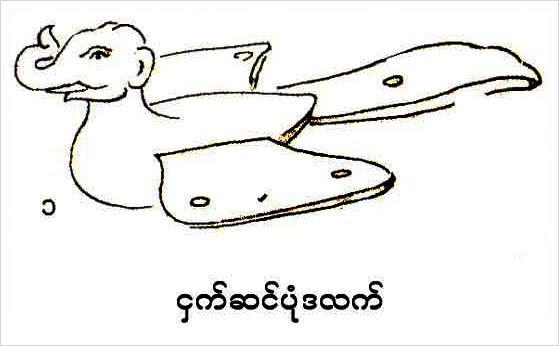
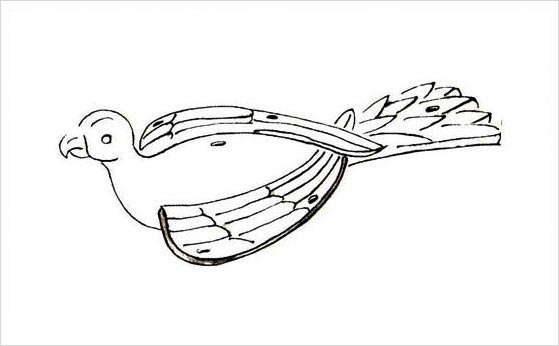
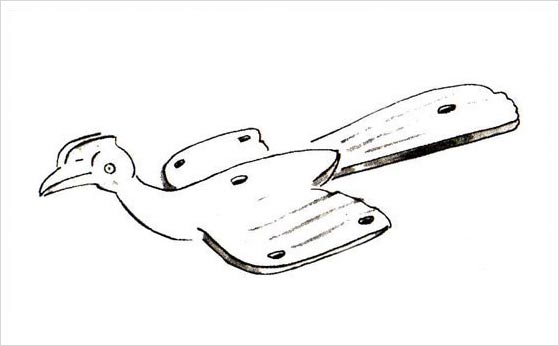
T-shape controls were used before H-shape handles were invented. Following were 6 different kinds of T-shape handles.
3.3.2.4. Basics of Controls
A good “handy” control was about the size of a human palm. “On the handle were points for fixing the strings and space enough for more than 60 strings, according to my own experience” said Dr. Tin Maung Kyi.
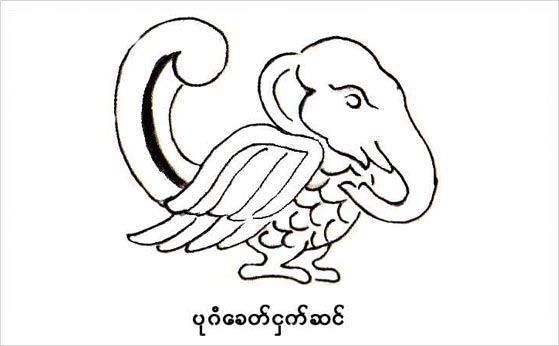
The strings that controlled stability (suspending) of the puppet were:-.
Head – 2 strings
Shoulder – 2 strings
Hip – 1 string
Total – 5 strings
So a Control needed five holes to fix them. Such holes were visible on H-shape handle. In the center of H shaped control was a string to hang the puppet on the wall. If that string was counted in, a “Control” had 6 strings and 6 holes.
3.4 Studies on Puppet Construction Art in the past
3.4.1 Preparing the Puppet-Strings
The records showed that old puppeteers used the following (tanning) methods for puppet-strings so as to make the strings last long, to prevent destruction by insects and rats, to make it pliable and easy to pick up while playing.
The strings were dipped in liquids of crushed “Tel”(Diospyros burmanica) fruit, or “Kha-yae”(Mimusops elengi) fruit, raw and ripe, or crushed “Yin-mar-bin”(Chukrasia tubularis) bark. A favorite color was added to the mixture and the strings were dipped in it for an over night and dried in the sun.
An alternative method was a crushed pieces of cactus added with a little sugar (so as to make the color long-lasting). The string was put into the hot mixture over half an hour. Then left it dipped in the mixture for one night. Next, the strings must be dried in the sun.
3.4.2 Introducing Asi-string and its uses
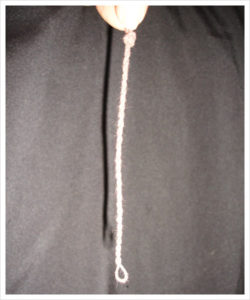
The puppeteers invented what was known as “Asi”string or Asi-kyo”.
(Note: puppet-researcher U (Oo) Ye Dwe suggested that “Asi-string” could be “Asae-string. “Asae” meant knob, round knot.)
Asi-string was a “single” string bent double on its own and twisted, leaving a small loop at one end for fitting a knotted end of a string. (See the figure)
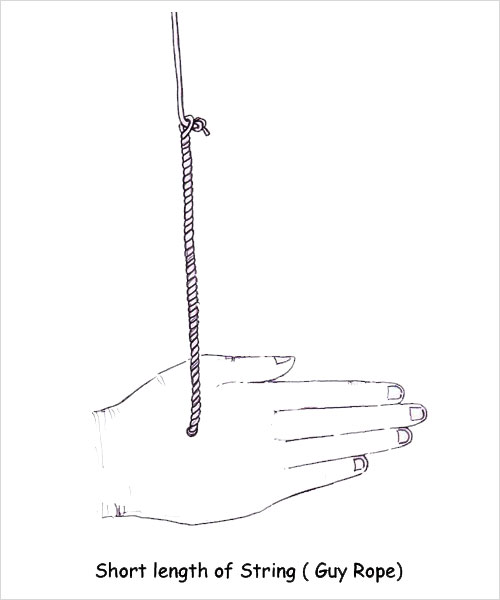
A puppeteer knew how to twist “Asi-string”. According to old saying, Asi-string method gave the following advantages advantages:-
(1) Before performing a puppet, the strings could be checked, cleared off entangling ones or cut strngs could be replaced in no time.
(2) Costume could be changed easily.
3.4.3 Suspending Strings
5 strings were to maintain stability of the puppets (hanging it from the Control) and others 6 were for movements or performance. There were 12 minimum number of strings required for a performance.
(1) Temple-string 2
(2) Shoulder-string 2
(3) Hip-string 1
(4) Elbow (thigh-root string 2
(5) Palm-tip string 2
(6) Princess’s foot-tip (no knee-string) 2
(7) Prince’s knee-string (no foot-tip string)
(8) Upper-chest string (optional) 1
Total 12
3.4.4 Manipulating Strings
With the exception of “suspending strings” for stability, the others were manipulating strings. The puppeteers introduced new strings, such as
– (Let-shet-kyo)- Bringing palms together for worshipping
– (Chay-gwin-yite)- striking the knee with the opposite foot
– Grasping (flexing) fingers
– Protruding the tongue
– Shaking the breast (mamma)
– Moving up and down the eyebrows
– Shaking the hips etc.
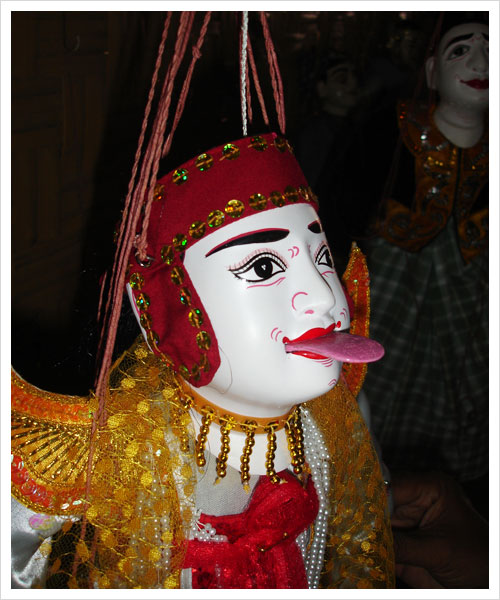
About BE 1295 (AD 1933) puppeteer Oo Win of Myin-gyan had installed (60) strings on his puppet. His control was set with innovated strings in such a way that by merely shaking the control, his puppet was found dancing.
There had been no (60) strings in the reigns of King Mindon and King Thibaw. It was a later invention in about the year 1900. Two puppeteers in Mandalay, two in Yangon and two in Hinthada were using such wonderful 60 strings.
U (Oo) Ye Dwe wrote in his “Puppets from Myanmar Marionette Theatre” that puppeteers Oo Tun Yin in Mandalay, Oo Aung Thwin (Waitza Thwin) in Hinthada played 60 strings puppets.
Further in the book of Oo Hla Tha Main, mentioned “puppeteers introduced new strings for new movement (dance) in different ways. In some performance like the Witch, the head left the body and flew overhead of the audience showing witchcraft (This is Burmese belief). After that it came back and joined the body again.
In performing “Hti-lat and Poe-Oo” story, a sword of a puppet cut into another puppet’s womb to take out the embryo. In other plays, in a fight scene, one puppet’s knife was left stabbed at the womb of other puppet. These were new special strings introduced by puppeteers.
3.4.5 Shaking Breast (Mamma) and a suckling infant
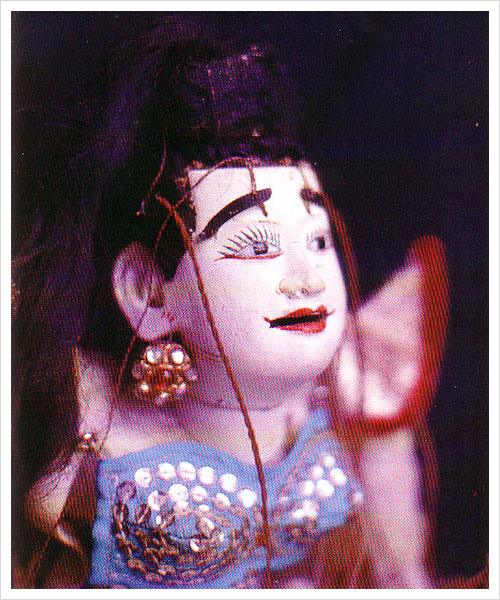
U (Oo) Pan Aye (Mandalay Marionette) who had been a member of Shwebo Tin Maung Marionette troupe told that the spirit medium performed “a special mocking scene”; here beads over area of her breast were seen shaking (operated by a pair of strings) as if the underlying breasts were shaking.
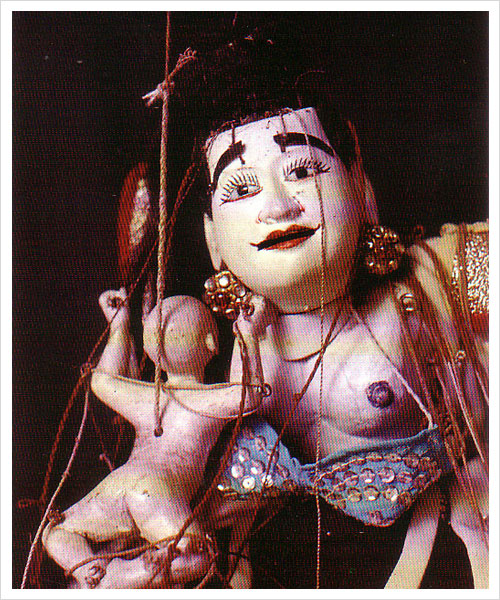
The next step was a scene of a suckling infant. First the spirit medium was put down sitting on the floor: a Control carved into an infant figure, was lowered down into her lap of the spirit; the brazier was slipped down (by lowering a hidden string at the back) now exposing the her breasts. Then infant was played about in her lap, while the oboe played the sound similar to the infant crying. It was a good effect!
Finishing the scene, the infant figure Control was pulled up by its hanging string. At the same time the brazier was pulled up to cover the mamma.
3.4.7 Kaolin for Face Make-up (Kin-Poot-San in Myanmar)
In the old days Modern paint (called plastic paint) was unknown; Kin-put-san (was a small soft and white color rock found all over the country; it was used as a chalk in the past) was powdered and added with a suitable color for face make-up. Senior puppeteers recommended the Kaolin from (Shwe Gyin) as the best for puppet make up.
To make a face make-up Kaolin rock was rubbed on a flat stone added with water. Water was not a problem. The rubbings would sink to the bottom and the supernatant water was discarded away leaving thick rubbing or paste.
When enough amount of rubbing was collected, the rubbing should be sieved through a thin linen or silk cloth. It was to get a smoothed surface effect on puppet face when dried up.
3.4.8 Tamarind-seed Glue
Paste/paint to be mixed up with Kaolin was Tamarind-seed glue. Two handfuls of seeds would be enough to paint a puppet. The seeds were “heated” mixed with sand in a dry frying pan to remove the outer covering. The sand would apply heat equally to all seeds. Then the coverings of the seeds were easily removed away.
Now the seeds were boiled in water nearly the whole day and water added to when necessary. Finally when the glue came out, the seeds were removed.
Now the glue was mixed up with Kaolin in equal proportion.
3.4.9 Coloring the Make-up
In the old days, paint or make up for the puppet was pure white color added with a little red to make a pink-color. For the senior Prince Puppet who acted as a villain, more red was added.
In painting scalp, eyebrows and eyelashes, black-ink or other black paint (lacquer) was used.
For painting lips and wrinkles vermillion red (mercury chloride) was used by mixing with tamarind glue. In the old days, it was learnt that red sealing “lac” of dry battery cell was used.
3.4.10 Painting The Puppet
Removing the old make-up and applying a new painting (make up) on the puppet was called ‘Sae-cha’ (in Myanmar) i.e. removing old paint and new one applied to. In the old days five cock-feather tips were tied together to use as a brush in painting the face.
The painting job was done in the sun; the puppeteer had to sit and paint. He had to wait upon his paint, to remove any thick trickling of the paint; that would not give a smooth face; he had to apply the paint seven times. This paint did not give a shiny reflection to light at performance.
3.4.11 Weakness of Kaolin Make-up
But a drawback was that the paint was always easy to get off. The traditional Kaolin make-up did not last long. Soon peeling, wearing away by friction and thinning soon followed. Then to avoid stain and scratches, the puppet’s face had to be protected covered with a velvet-mask.
Even then chin-tip and nose-tip never escaped thinning of the pain as the paint was rubbed off from these areas. (These were the pressure points). To avoid it, a small piece of Mai Kai paper (name of a village from Shan State, Myanmar; it was a thin Mulberry paper) was soaked in water and put on the defect before the paint was applied.
But, now, a more durable, less tedious and easy to apply “plastic-paint” replaces the old one. And a color could be added as required.
3.4.12 Carving Yamanay (Gamelina arborea)
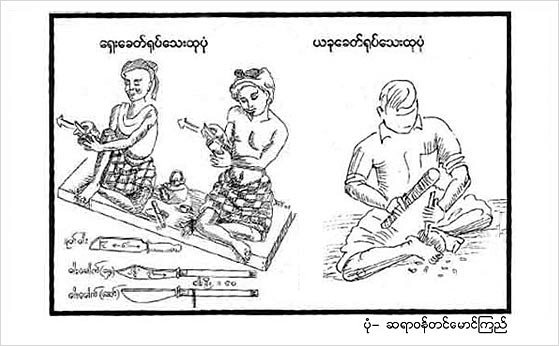
Before a carving was started, tradition demanded: –
(1) to select an auspicious day (in accordance with astrological prediction)
(2) by dipping the wood in the water to find out heavy part and light part (the root and the top)
(3) light part was selected for upper part of the body and heavy part for the lower.
(4) some experts also told that the heavier part was used in carving onyx and the lighter part was used for carving face.
Gamelina arborea was the lightest wood and fit for carving puppet especially for dancing ones. Other puppets were mostly carved from other light wood but not superior to G. arborea; examples- Myitzu, Letpan, Pone-me-za, Ma Au, Than-that and let-htoke.
In carving the puppet in the old days, ‘Khote dah’, ‘dah-mauk’(2 types) had been used. These were sharp blades with long handles. Dr. Tin Maung Kyi, the Puppet Researcher, found out this fact.
First a piece of wood was shaped into a rough image with ‘Khote-dah’ (a shorter blade in the image). Then choosing a curved blade, its long handle was clamped or pressed between right elbow and right knee. (See the figure). Right thumb pushed the back of the curved blade. By pushing right knee outward (arrow guide in the figure) the wood was cut by the curved blade.
One could carve an image in the same way as above without the aid of the knee.
With the point of the curved knife, details of eyes, nose, mouth and ears would be made. If one wanted to hollow deep into head and body, other tools like chisels were used.
3.5 Observation on Today construction of Professional Marionette
Myanmar puppets followed after the model of the puppets of Royal Marionette stage. The puppets of the Royal stage were 27 inches high and the puppets of the commoner stage were 24 inches. Increase in height and size made heavier specimens and were discarded later on.
Today U (Oo) Ohn Maung from Mandalay made many puppets for use in Mandalay Marionette Theatre. The following were steps recorded from his discussion.
(1) Choosing wood for puppets
(2) Carving them
(3) Painting them
(4) Preparing or Tanning strings
(5) Joining all anatomy
(6) Wearing Costumes
(7) Fixing suspending and manipulating strings to the ‘control’
3.5.1 Choosing Wood
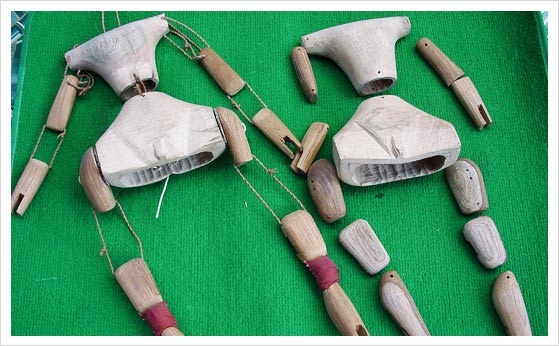
As discussed before, Myanmar puppet were made preferably with G. arborea.
Later Yamanae wood became scarce and it was substituted by Teak. The Teak was easy to get, resisting to insects and durable, but rather hard for carving.
Video – Ko Win Myint [video_lightbox_youtube video_id=”Wvg-VEdrTkE&rel=false” width=640 height=480 anchor=”https://myanmarupperland.com/wp-content/uploads/2020/10/Video-logo-small-25.png” style=”” alt=”” />]
Video – U Ohn Maung [video_lightbox_youtube video_id=”_xrpB_T7hKo&rel=false” width=640 height=480 anchor=”https://myanmarupperland.com/wp-content/uploads/2020/10/Video-logo-small-25.png” style=”” alt=”Smiley face” />]
3.5.2 Carving Puppets
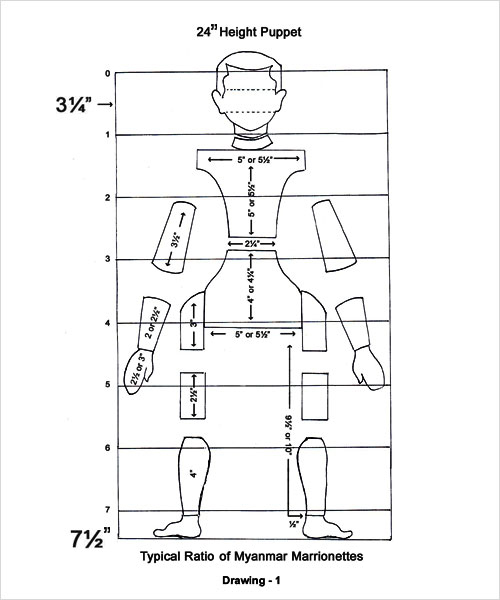
For a 27 inch puppet:- Head – from edge of the forehead to the chin – 3.5”
For a 24 inch puppet: Head – from edge of the forehead to the chin – 3”
For a 27 inch puppet:
– forehead around the ears was 8.5 inch to 9.5 inches. Sometimes the size slightly varied. The circumference gave a standard head. Its face became a measure; seven and half times of it gave a height of a puppet. The height’s half was an arm’s length.
The length of the head from hair margin to chin was 3” to 3.5”, the whole body was carved proportionately.
See figure or drawing 1 and 2
As has been discussed, the puppet head from forehead to the chin would be 7 ½ times – to make its height. But later the strings and joints would lengthen from 24 inches to 26 and 27 would become about 28 inches.
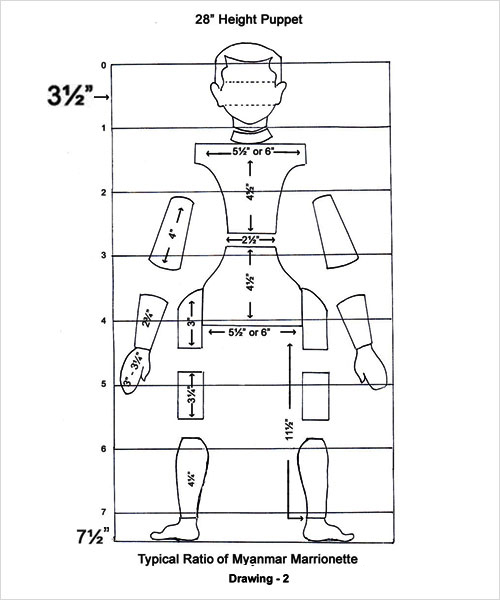
Nowadays there were two different carvers – one specializing in head and other in body. One who carved the head only would have to provide neck-piece, hands and feet also. Assembly of the whole anatomy could be seen in the following figure.
Importance: The head was carved in such a way that it should be inclined forward. A good specimen was a puppet looking above when hung on the wall. (Buy such specimen!) (See drawing 3) When the puppet was put in a dancing posture, it was found looking straight towards the audience.
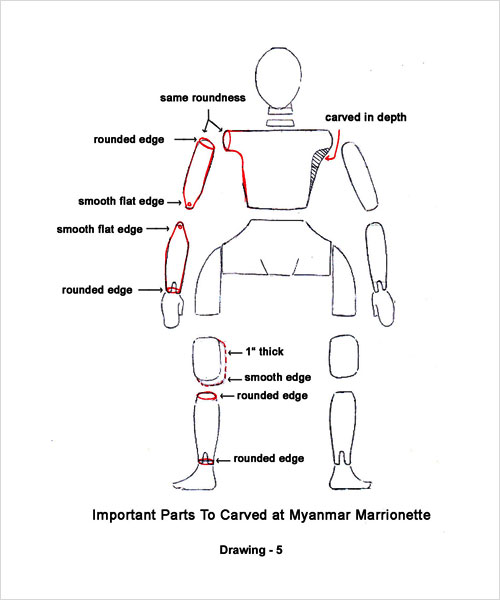
Importance: There must be no sharp edges (but the edges should be rounded and smooth) at the shoulder tips, arms, forearms, thighs, and legs. Rounded edges facilitated movements of the parts or components.
Sharp edges will interfere with movement especially when the gap (joint) was filled up with soft cloths.
3.5.3 Painting the Puppet
Before applying the paint, wood surface was smoothed with a sand paper. Then liquid paint (already mixed with glue) was applied 7 times (one after the other dried) in the sun. After drying it needed smoothing with fine sandpaper.
Modern paint or Plastic Paint as commonly called now, was found easy-to-use and long lasting and hence it was widely used.
3.5.4 preparing to have long lasting strings
Now-a-days Sha-say (Cutch) was used to color the strings instead of barks and fruits previously discussed before. After drying, the strings were rubbed well with bee-wax. This wax would resist oily stain and sweat of the puppeteer.
3.5.5 Connecting the parts of the body with joining strings.
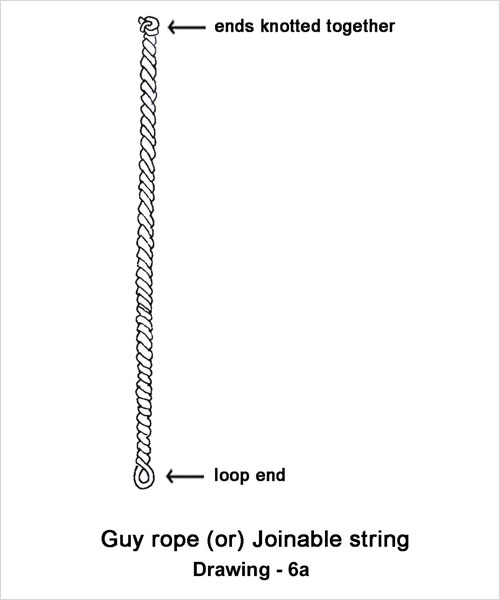
How an “Asi String” was made by twisting had been discussed above and no detail would be made here. It was a string folded double on itself and twisted one upon the other, leaving a loop at folded end. (See figure or drawing 6a)
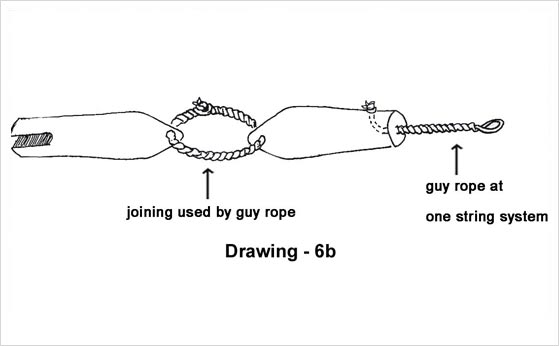
The “Asi” was used not only for joining the strings between the puppet and the Control but also in joining wooden ends at the joints. The end with two separate strings was knotted together.
How the “Asi” was used to join wood ends was shown in 6b.
Plasticity (mobility) of a joint be rendered as required; it could be also adjusted by the “Asi” strings. This “Asi” string was and still is found only in Myanmar and it is definitely our own invention and not borrowed from anywhere!
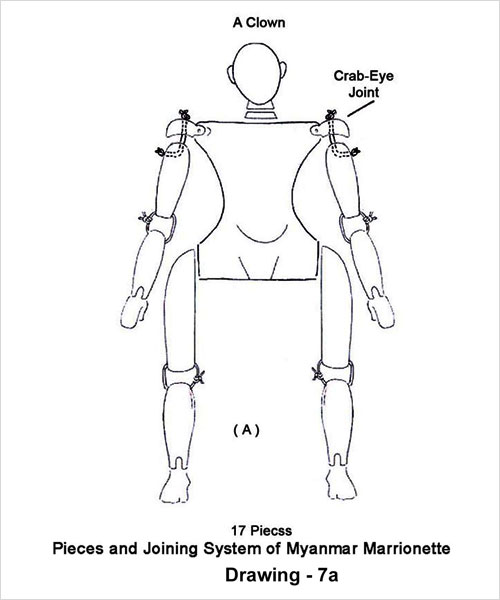
As the above figure showed, the whole anatomy has 18 pieces including neckpiece. See Figure 7-a.
Those 18 pieces were joined with “Asi” strings. To lighten the weight of the wood, the upper (chest) and lower body (hip) were hollowed out. Head was also done the same way. In joining the 18 pieces by “Asi” strings, the end remaining after tying a knot, was left one or 2 inches longer in order that adjustment could be made well later on.
A special joint was discovered and noted by Dr. Tin Maung Kyi. It was known as “Crab’s eye” joint after its similarity to protruding eyes of a Crab. This special joint facilitates easy movement at the shoulder joint.
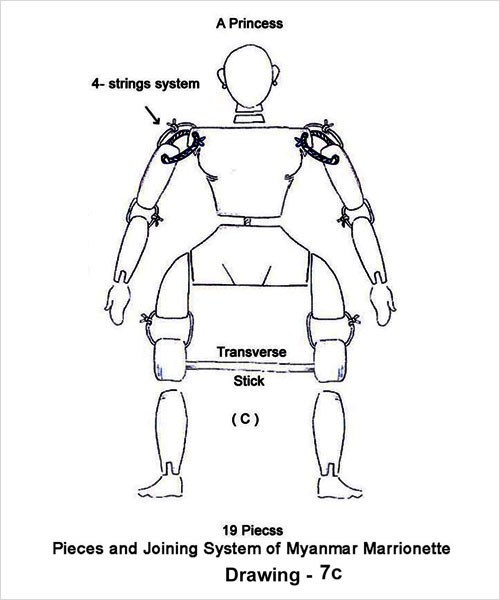
In joining swift moving Zawgi (Zaw-gyi) puppet, Ogre (Demon) and Pageboy (Thu-nge-taw), waist gap would be narrower than that of Prince and Princess. Elbow-joints were also joined narrower in former. Please note “Asi” string was mentioned in former translation as “Guy rope.”
In all the joints, if an exact gap was required, a block of wood was placed between two ends before fixing the “Asi” string. (See 8a)
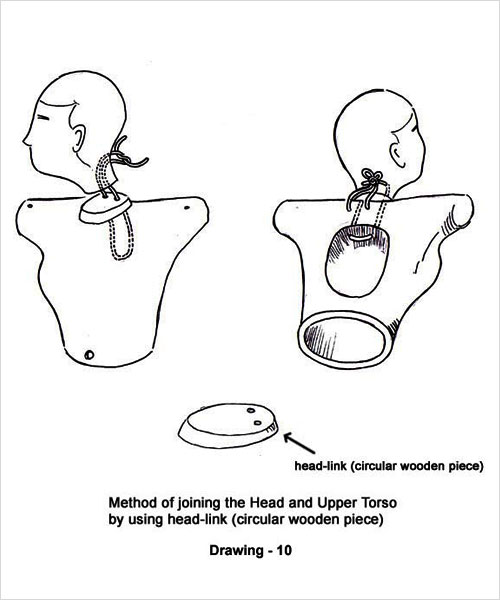
In fixing the head-string (see figure-10) 2 stout/thick strings joined the shoulder and head. A neck piece intervened between the two. This double strings invented by Dr. Tin Maung Kyi, acted well for a “spring back” mechanism when the head was turned to one side.

Formerly (instead of a double string), a single “thick” string passed through a single hole (in the neck piece) to be connected to the head. But the defect here was when the puppet head turned to one side, it might stay there without coming back to its previous position; in such a case, it would be an ugly sight.
Finally, the two strings passed through to the back of neck (see the figure) and tied together firmly, thus securing the head to the neck. Those 2 strings were called “life-string” was made to make the knee flex in a normal and natural way. In front of the knee-joint, a firm circular piece added between the wrapping linen. It would act as a “patella“ (Gon-nyin in Burmese) preventing un-natural flexion of the knee in dancing. If this un-natural flexion, occurred, it was an ugly scene. See figure (11)
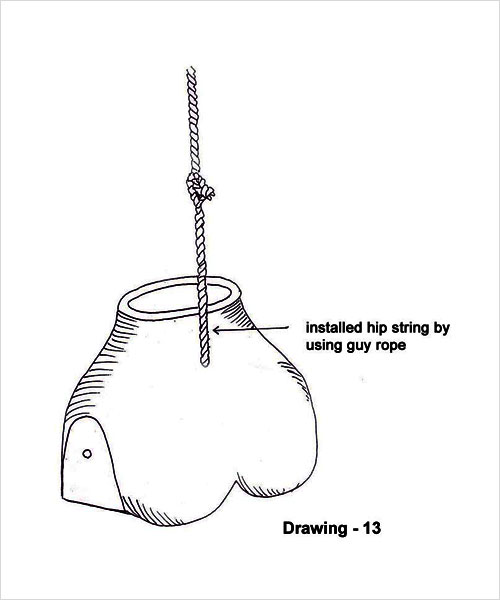
Guy rope (the looped end of “Asi” string) would be put through the hands.
Striging the Hip Here an “Asi” was fixed first through a hole from inside the hip and then out it came. The drilled hole should be at a point between upper one third and the lower two third at the back. (See figure 13).
3.5.6 Wearing The Costume
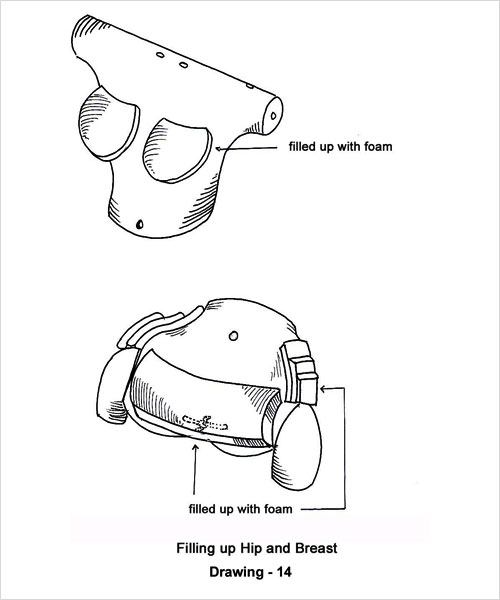
After finishing joints and before wearing the costume and, the whole anatomy was inspected. See for any abnormal bulges or any smallness of the parts or disproportion. Now-a-day plastic foam could fill up at necessary places like breast and buttock.
In the old days, hip and breast were filled up with pieces of cloth. Now-a-days, easily-available materials like plastic foam could be used to fill up a gap. Thus whether the puppet be a Prince or Princess, a good shape could be made. See figure (14).
When costume was put on, it should fit in allowing an easy movement of the joints.
When costume richly embroidered with sequins etc. were put on, special care was taken at the joints. If the embroidered cloth over a joint was too thick here a freedom of movement at the joint was not possible. So a precaution was taken that there should be a thin embroidery of costume over joints.
Putting on the costume-sarong, skirt, or pants were put on to cover the lower parts of the puppet. Then came costume for upper part of the body-like jacket, robes etc. The jacket and skirts should not disturb the freedom of movement at the waist. Special care was taken to keep embroidered pieces neat and tidy using if necessary stitches or even in and nail at places where necessary.
While wearing the costume, the “Asi” strings were pulled out through small holes on the costume.
The role of the Tapestry as mentioned by specialist U Sein Myint:-
“There were 10 different kinds of arts in Myanmar tradition. This tapestry went under “gold–smith”. He delivered a lecture on this topic at East West Centre in Hawaii. This art could be traced to a thousand years back.
After successful military campaigns over Ayutthaya and Manipura, this art became enriched added with western idea, design and decoration materials. The art became more popular at the court of Konebaung Dynasty. Gold and silver embroidery were found in costumes of kings, queens, ministers and all high officials.
Elaborate designs and materials differed according to official and social status. This embroidery was found in many items telling a status and rank e.g.pillows, horse and elephant straps, curtains, covers etc.
Similarly in the past, embroidery was used in decoration of the puppets eg. Crowns, headbands, jackets and robes, sarongs and skirts, belt, bali-kwe (chest cover), shoes and so on. Other paraphernalia such as cups, boxes, thrones, curtains, partitions, musical instruments.
Many materials were used for decoration. These were: –
Sequins, Naga-htar strings (colored thread entwined with gold and silver threads), glass beads, semi-precious stones etc. Other special items and names of the designs used in this art work were many:-
Sequins- embossed into stars and cup shape, gold threads, naga-htar etc. A peculiar shaped small piece of wood was known as Tortoise; the Naga-htar threads were wound around it.
3.5.7 Suspending Strings to the Control
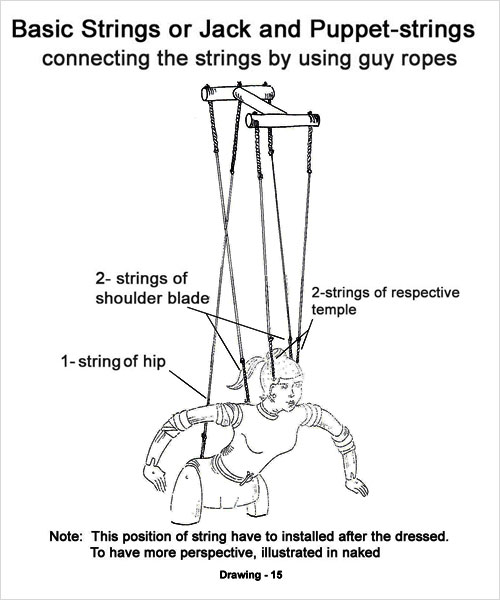
Controls were mostly “H” shaped and about the size of a palm. Different designs of them had been discussed in previous chapters.
H shaped control Usually the front cross bar of the “Control“ had 2 holes for fixing 2 head strings from the puppet. See figure (15). The back cross bar was for a pair of shoulder strings. The connecting bar between the two cross bars was provided with a hole for fixing buttock string. The hole was made nearer to the cross bar at the back.
These 5 strings were to suspend the puppets to the Control and maintain stability of the puppets. They were not dancing strings nor for movements. But without them, as they all maintained stability, dancing strings could not be played with.
Here a special attention should be paid to hip-string:- U (Oo) Ohn Maung noted that the hip-string of the puppets in Shwe Bo Tin Maung’s Marionette used thicker and stronger strings for hip.
Any strings (except Hip String/Buttock String) could break or separated during dancing; here a clever puppeteer could hide the mishap and go on manipulating as if nothing happened. The puppeteer continued his puppet dance without disturbing his audience.
But when the hip string was torn away, the puppet virtually went out of control and the puppeteer could not continue his work; he would be forced to stop.
– Placing the “Buttock String” to put the Puppet in Dancing Posture
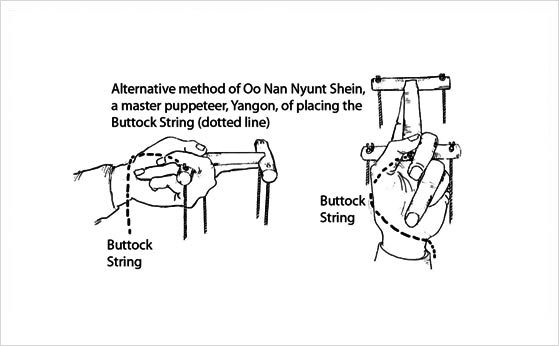
First the connecting bar of the Control was put on left index finger (and in line with it) as shown in diagram.
The thumb and middle finger of the left hand grasped the back cross bar. The other ring and little fingers were flexed below the cross bar. These fingers will be used in manipulating the (three loop) strings during manipulation.
The Buttock string arising from the Control rope of the jack that connected to buttock-string went down along a fold between the two eminences of the palm. Here the middle finger firmly pressed the hip string keeping it in the folds.
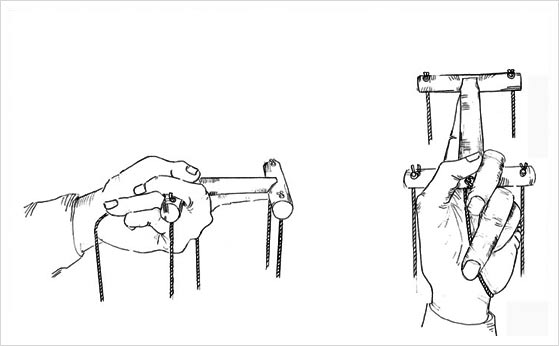
Holding the Buttock String like this made the puppet bent forward and the dancing puppet assumed a posture characteristic of all the Myanmar puppets; now the face of the puppet was facing directly to the audience.
There was an alternative method by Oo Nan Nyunt Shein. (See figure)
Advantages were:-
(1) It was easier.
(2) You don’t need to press the buttock string.
(3) These free fingers could be used for all purposes in manipulation.
Now the puppet was ready for a play or a dance. To do this, three loop strings from knees, hands, and elbows were brought up 9 inches above the control (ready for playing a dance) or let them rested on the connecting bar of the control (if not to play yet). These were manipulating strings.
The Guy rope (Asi string) connected to the Buttock String was also thick. The intention was to prevent damage or cut. If that Buttock-String was cut off the puppet lost its stability. That was why, that hip-string was called “Life-line” of the puppet.
3.5.8 How to hold and play the Manipulating Strings
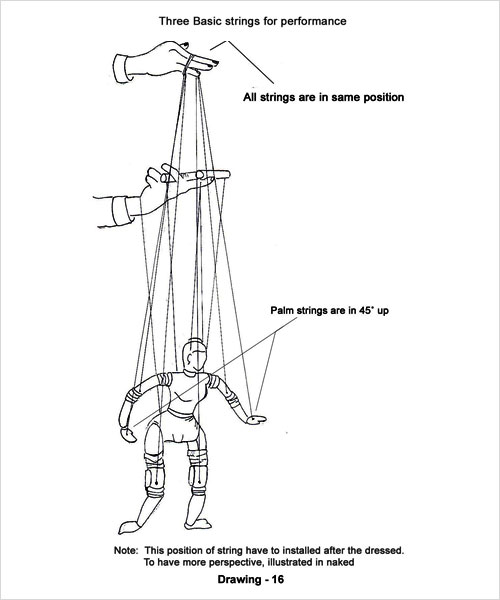
There were 3 main strings to play the puppet. They were not attached but free loops brought up over the Control. They would be manipulated by the right hand. They were:-
(1) 2 hand strings. A loop, its ends connected to hands.
(2) 2 elbow strings. A loop, its ends connected to elbow.
2 Knee strings. A loop, its ends connected to knee All together 3 loops. (See figure -16).
The 3 loops were brought up together by the right hand 9 inches above the control, as already discussed.
3.6 Difference between Marionettes from Upper and Lower Myanmar
A discussion on carving, joints and stringing of the marionettes are presented here by Oo Ohn Maung, a scholar puppeteer/Puppet Maker from his practical experience.
Before discussion on this topic, the following anatomy will be presented first. (In further discussion, the term puppets will be used for marionette to make easy understanding.)
During the time of the last king in Mandalay, there were Sin-daw-gyis, (the Greater Puppet Stage) and Sin-daw-galay (the Lesser Puppet Stage or Tha-mee-daw’s Puppet Stage). In Sin-daw-gyi, 27 inches height puppets (one arm length and a hand-span) were used. In Sin-daw-galay 24 inches (one arm length and a first) were used. (Figure)
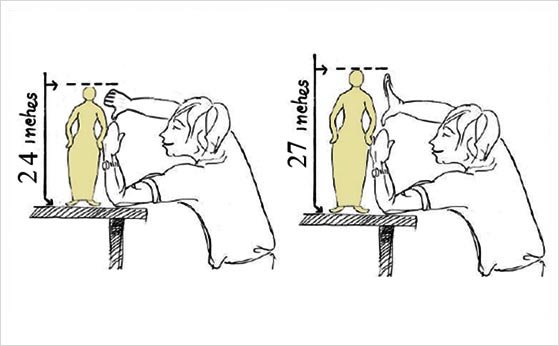
Regarding 27 inches, there was a formula –
“A hand-span around the head + four fingers.
This is the optimum size of a head, and this forms a standard unit.
Seven and a half of this unit is the height, equivalent to an arm length plus a hand span.
Half of this height is the arm length. (See the figure)
So length of a face is 3 and half inches from hair margin to chin; 7 and half times of this face is height and half of height is arm length.
For 24 inches puppet, face is about 3 and one-fourth.
Standard measurement in the past was not in inches or meter but one’s own hand and fingers, allowing differences depending on personal variation. So naturally there was slight variation in height of each puppet.
Generally dancing puppets like Prince and Princess were smaller than clowns and other characters. In Sin-daw-gyi (where height was 27 inches), the difference was not very much, may be not more than one inch or so. Here the height of a clown would be 27 inches and Prince and Princess characters are about 26 inches.
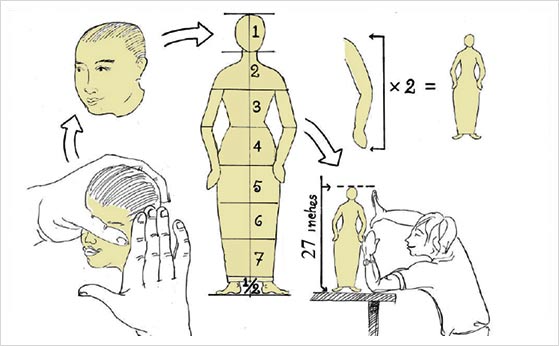
Similarly in Sin-daw-galay, the clown may be 24/25 inches and Prince and Princess would be 22/23 inches.
After Shwebo Tin Maung’s Puppet Troupe was gone, a new puppet stage came up in Mandalay in about 1988. It was “Mandalay Marionette”. In its initial 3 years, different sizes of puppets were used on the stage, both 27 and 24 inches. These were made by the puppeteers Oo Mya Thwin and Oo Pan Aye. That was why different sizes of puppets were found in earlier years.
After Oo Mya Thwin’s demise, Oo Pan Aye continued making of the puppets. After Oo Pan Aye’s retirement, Oo Ohn Maung started the production line. A mass production needed many parts of the puppets to be made – all in the same size and standard for 24 inches height except Monkey Puppet. So all the standard size costumes were made to fit in all puppets. From 1993 to 2007, in a span of 14 years, all the puppets characters were made in mass production, the size being 24 inches. It was the size used in Sin-daw-galay.
One thing to be noted was that cotton strings joined all parts. In course of time after many manipulations, the strings became more or less loosed and lengthened, and the height of the puppet was naturally increased by about one inch; a 24 inches would become 25; 27 in. would become 28. In spite of this lengthening, it seemed that the head and body ratio were not altered significantly.
However by now all puppets put on sale in the markey in both Mandalay and Yangon are all made in the same size- all 25 or 26 inches. But “the head is found smaller than it should be in proportion with the height.” Or the head and height ratio is altered.
In presenting all these facts here, Oo Ohn Maung is afraid that some one might run away with the idea that he was “bookish,” sticking to old rules. In fact he wants to convey a message to those foreigners studying in Myanmar puppet researches that Myanmar puppetry has to follow traditional rules.
So his discussion further will spot light in difference or variation in (1) carving, (2) in attaching the strings and (3) in costume.
(1) Difference in Carving
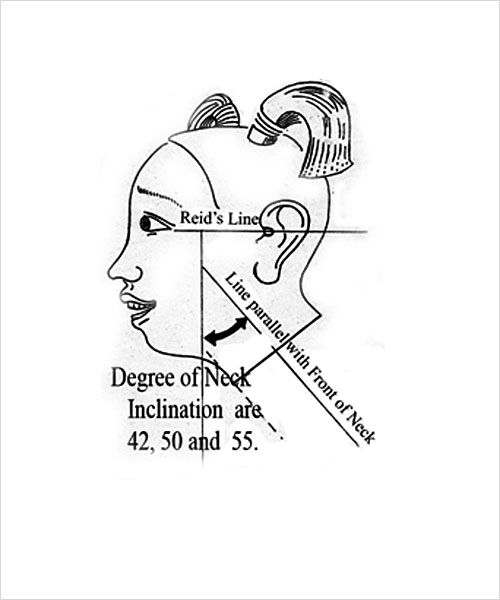
– There is not much difference in sizes of head both in Mandalay and Yangon.
The circumference of the head around the level of ears is found to be 10 and half inches; the length of the face from hair margin to chin is 3 and half inches. (The circumference of the head is generally “one hand-span plus four fingers”). See above Figure by Dr.TMK
– For a 24 inches height, around the head is 10 inches and length of face from hair margin is 3 and one fourth inch.
– However 27 inches puppets are no more found; instead 24 inches are found in the market. But the head ratio is not proportionately changed all in Mandalay and Yangon. Sometimes the head is found smaller about 3 and one-fourth or 3 inch while height is increased. This is out of proportion and looks bad to one’s eyes with a good sense..
– Hair margin is marked with a small “grooved line” in Mandalay made puppet but not in Yangon puppet or if done the groove is too shallow or just a mere line.
– All along the hair margin, little holes are made to insert tuft of ‘real hairs’ in Mandalay puppet. This is the only method usually done. In Yangon puppet, a web of black cotton thread covers the hair area and secured with small nails driven into it.
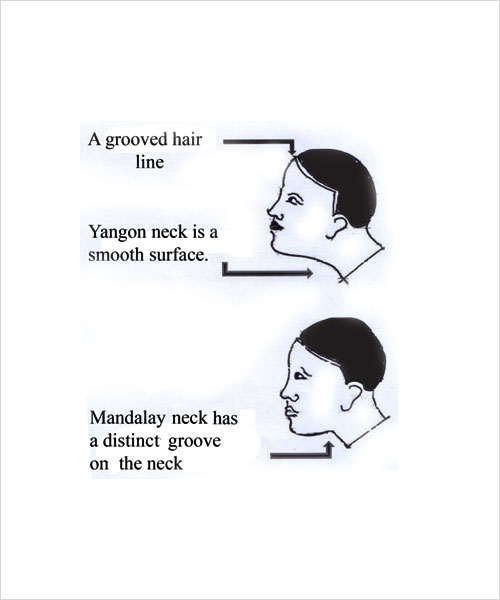
– Degree of inclination between the head and neck are the same in both.(a figure is necessary)
– In Yangon puppet there was a smooth and continuous surface running from chin to neck.
– In Mandalay puppet there is a distinct groove between chin and neck. (See the figure given below by Oo Ohn Maung) So the neck here looks graceful. Neck is usually decorated with necklace around it.
The head, neck piece and thorax are provided with a pair of small openings, each would allow a string. Thus the three parts are held together to make a neck-joint. This type of joint is found in Mandalay at the time Oo Mya Thwin and Oo Pan Aye join Mandalay Marionette.
– In Yangon puppets, the same joint is made with a thick string passing through a single opening in each part. (a figure is needed).
– So the neck piece has two openings in Mandalay puppet and one single opening in Yangon.
– Head, neck piece, upper body (thorax), lower body (abdomen), arms, fore-arms and upper thighs, lower thighs, legs, foot are altogether 18 pieces. The total number is the same in both Mandalay and Yangon.
– But size for each have different size and shape in both places, even differing in each locality.
– In Mandalay length of the thorax at shoulder level and length of the buttock are the same. The upper thigh piece is thinner.
In Yangon, the buttock is shorter than the thorax and this is compensated by using thicker thigh pieces. For example, for a 27 inches height puppet, the thorax is 5 inches and the buttock is shorter – just 4 and half. But as usual, upper thigh pieces are made thicker.
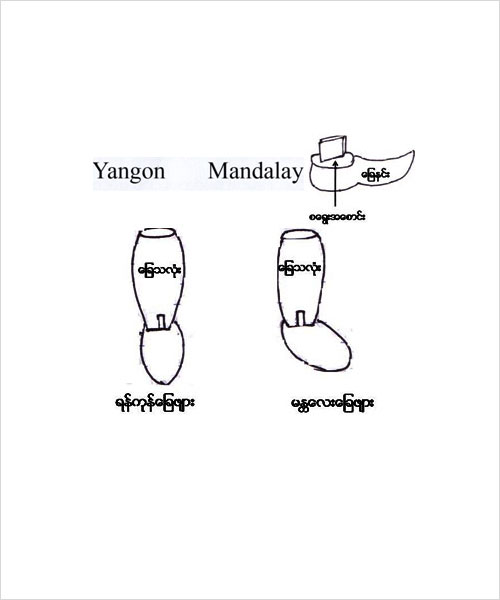
– In all Yangon puppets, the wedge of the foot is inserted or made in such a way that it fits into the leg and the toes are found pointing forward. In Mandalay, the toes are directed outward in a natural way. (See figure )
– For breast and buttock, where a bulge is necessary, pieces of cloth or thrown-away threads from looms, or plastic foam are used in Mandalay puppets. Yangon puppets do not need this reinforcement as the necessary bulges are made in carving.
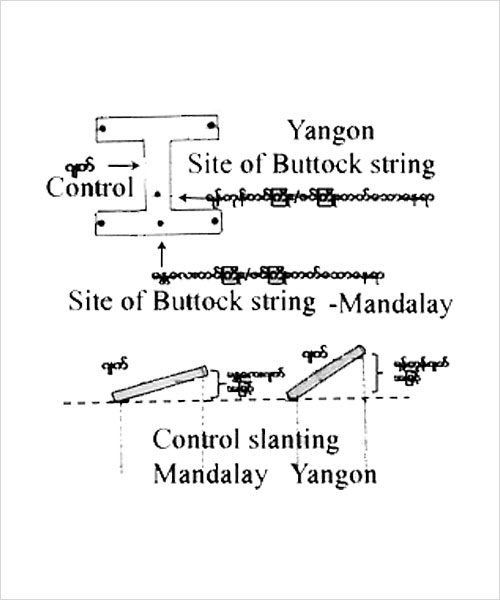
– In pageboy puppets of Mandalay, the hands are found with pointing forefingers.
– In pageboy puppets of Yangon, the hands are just open palms.
– In Mandalay, the carvers did final touch to different parts of puppet with sand paper. However the head, hands and feet are all done again with fine sand paper by the puppet maker and subsequently Mandalay pieces look finer in appearance than Yangon.
– Yangon pieces are found crude mostly as they are not treated with finer sandpaper.
– About body parts that usually go under garments, Yangon pieces are roughly treated. Finer finished pieces are rare.
(b) Differences in Stringing
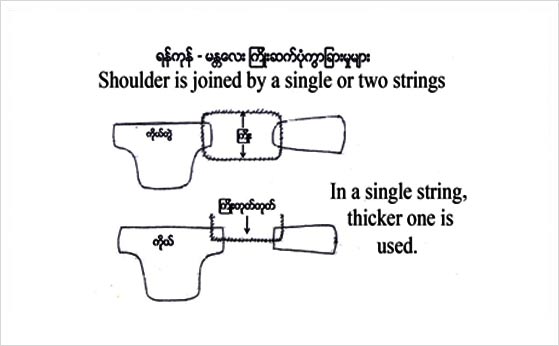
– In Mandalay puppets, shoulder joint and upper arm are joined by two strings in the past (see the figure), but now a thick single string is used instead of two.
– In Yangon, two strings are now in use.
– In both places, the following strings are the same.
Basic strings – 5 (2 for head, 2 for dorsum or back and one for buttock) Manipulating strings (for dancing purpose) 3 double strings (for hands, elbows, and knees).
– But anchoring site of strings for buttock on the control is slightly different.(See figure)
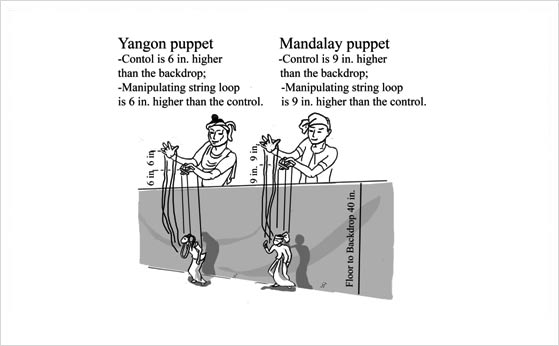
– All the strings are attached to the control in such a way that the control is slanting a bit (see the figure) but the degree of the tilt (slanting) is significantly more in Yangon.
– Control of the puppet is usually held close to the middle of the chest while the puppet feet are touching the floor. So if the puppeteer’s height is tall the length of the strings is found longer. So if the puppeteer’s height is short, the strings are shorter.
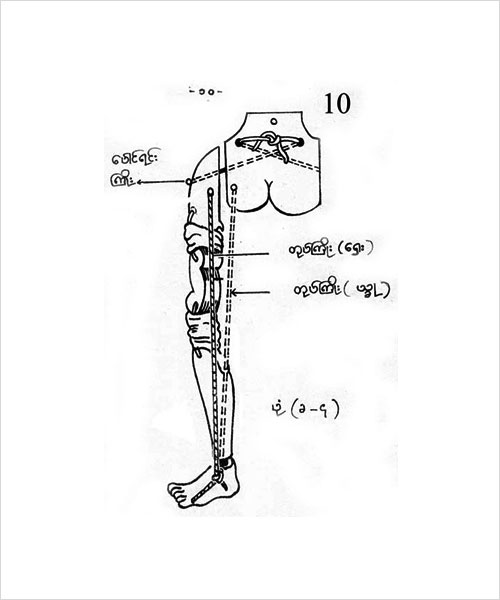
– Generally speaking, in Mandalay puppets, the control is held higher 9 in. above the backdrop. The manipulating strings held by right hand are also 9 inches above the control. The backdrop’s height is usually 40 inches.
– In Yangon Puppet, the control is 6 in. above the backdrop and the manipulating strings by right hand are just 6 inches higher than the control.
– ‘Asi-kyo’ or ‘easy loop’ (twisted loop made to attach and adjust easily to strings) are passed through the wood of the puppet. The way these are made is the same in both places. But small metal rings are more used to attach ‘Asi kyo’ in Mandalay puppets.
– In Princess puppet of Mandalay a special string mechanism is employed to control knee flexing in natural way.(See figure).
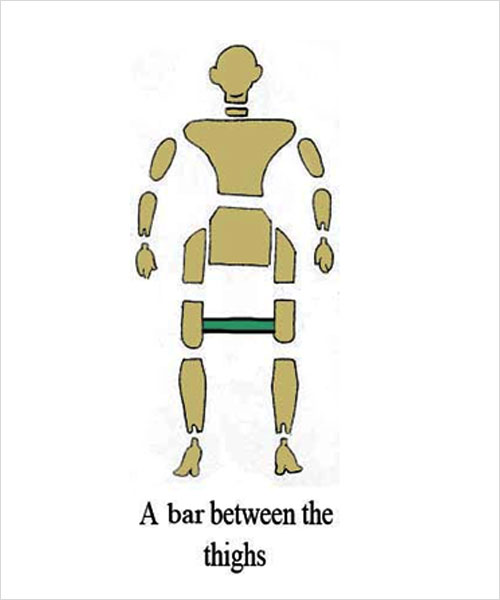
The foot string passes through a metal ring behind the thigh.
– Yangon puppet has no such control strings. A string for knee directly arises from the knee.
– These are all the common strings in both places. Other strings meant for special purposes will not be the same.
– A special string to pin down the arms to the side of the chest is found in Mandalay puppets but not in Yangon puppet.
– A wooden/iron bar is fitted between lower thighs in Mandalay puppets. The bar is hidden under the skirt. This is to control the knee spread in dancing.
– No such bar in Yangon puppets.
– In Mandalay princess puppet, knee joints do not need a ‘patella’ as in a natural joint. But its abnormal ‘bending’ with knee pointing ‘backward’ is prevented by a special string mechanism behind the thighs.
– A ‘patella’ piece is fitted in front of the knee joint to prevent abnormal bending of knee. This is found in Yangon puppets.
– The princess puppet from Yangon can raise her knee and walk like natural. But the Princess puppet from Mandalay could not do like this. Instead it walks in a gentle way kicking her skirt back with each movement.
– So the Mandalay Princess can dance kicking back her skirt back, a beautiful stance or movement not found in Yangon counterpart.
– Zaw Gyi, Page-boy and Monkey have a narrower (waist) joints than those in Prince and Princess.
– In Yangon puppets, the waist joint is wider at the back than at the front as the strings used in joining are attached longer. So the joining strings at the back are longer than the front.
– “Zaw Gyi” (alchemist puppet) of Mandalay has a walking stick (rod or magic wand) dangling from its right hand, by means of a small metal ring (Aye-gwin). The rod is usually a ‘cane’ painted red. The left hand is provided with a string loop for admitting the tip of the cane rod. When the tip of the rod is to be freed, the right hand string is pulled up.
– This arrangement is not found in Yangon puppet, where the magic wand is covered with red velvet. This velvet hinders or made difficult to release the string loop.
– So when the Zaw Gyi from Yangon made a somersault, both hands are raised above the head.
– When Mandalay Zaw Gyi made it, the free wand dangling from the right hand is flung and thrown on to the right shoulder. A good balance and a lot of practice are necessary to accomplish this successfully.
– Horse Puppet. ( Mandalay horse is made up of only wood and all joints are made as usual.)
– Yangon horse puppet is provided with one special joint- (neck where a cane ring is fitted in
– between the two wood pieces. This facilitates the joint movement. Moreover outside of the joint is covered with a strip of cloth. Thus Yangon Horse puppet has a graceful movement of the neck better than Mandalay Horse.
– Three separate pieces made a leg in Yangon horse puppet. But Mandalay horse puppet has either 3 or 4 joints in its legs.
– Prince Puppet In Mandalay, a string is attached to the heel by passing through an “Aye Gwin” (small iron ring implanted into the heel). A long loop is attached and connected with its counterpart on another heel, making it a manipulating string loop like the other three, called “Thone-Bin Gyo”.
– This string on each side coming up from the heel goes up back of the thigh where the string passes through another Aye Gwin or a large safety pin attaches to the buttock.
– But in Yangoon puppet, no such arrangement exists but a string loop is employed instead.
Difference in Costumes
– Heads of puppets like Rama, Orgre, Monkey, Minister, Garuda, Naga, Hermit, Deva etc. are all decorated with gold and glass mosaic in Mandalay. Mostly these are all painted in Yangon, with variation in each puppet troupe. Even velvet shoes decorated with sequins are worn sometimes.
Regarding the feet of the puppets, some are gilded, some with glass mosaic, some are painted, a wide variation existed in all Yangon and Mandalay.
– As for the head, natural human hairs are implanted into the head. But now artificial hairs or black threads are used instead. Even hair knots are now carved on top of head.
– Hair knots or hair-do is different to make and in these heads where natural hairs are used for hair-do, untidiness is a rule as redresing is difficult. Artificial hairs or black strings are easy to dress-up. Cotton threads are now found mostly used for hairs in Mandalay puppets.
– In Princes and Princess and other characters, sequins and embroidery are used for headbands, headdress, collar, shoulder cover, wrist-cover, pants, robes etc. Mandalay sequin-works are found more elaborate.
– Regarding necklaces, some used beads and some prefer to plastic garlands. More beads and longer necklaces are found being used in Mandalay puppets. 3 or more necklaces are used to decorate a puppet. Beads are hung down reaching lower than the level of hands.
– Yangon puppets are found decorated with less number of necklaces, and found shorter than the level of hands.
– Hooking up the beads with tip of hands. Mandalay puppets are purposely made with softer shoulder joint in order that the arms are easily used to facilitate hands in picking up the beads. Hands of Mandalay puppets can pick up beads using one or both hands. In order to do this successfully, vigorous exercise is made repeatedly by clapping both hands and bringing tip of both hands in the middle. Here the body is made steady; the swinging of the body is not necessary; the hands should be able to pick up the beads without the aid of the swinging body. To accomplish all these with ease, the shoulder joint is specially prepared “soft” and the number of beads many and longer.
– In contrast to this, Yangon puppets are found swinging the body in an effort to pick up the beads. Another point is that they never pick up beads with two hands.
Copyright © Myanmar Upper Land | culture & travel



